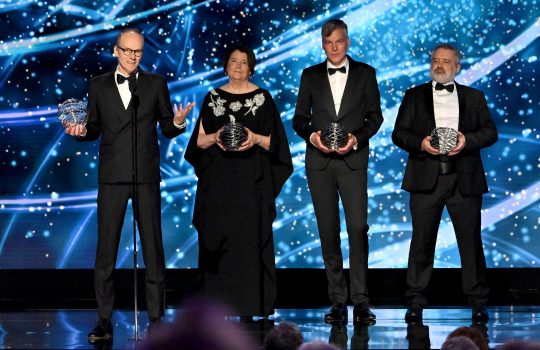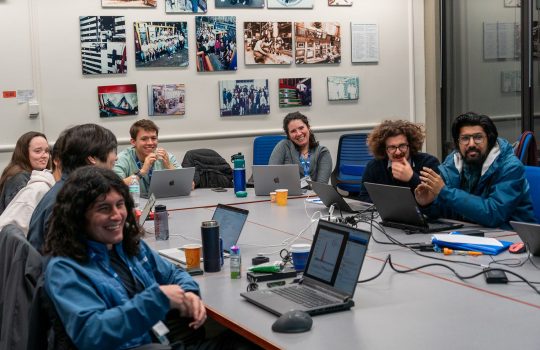U.S. and European officials today signed an agreement for U.S. participation in the Large Hadron Collider, a particle accelerator under construction near Geneva, Switzerland. When completed in 2005, the 16 mile (27 km) circumference accelerator will be the world’s most powerful. The new accelerator is being built at the European Laboratory for Particle Physics, known as CERN. It will bring protons into head-on collision at higher energies than ever achieved before to allow scientists to penetrate still further into the structure of matter. The Large Hadron Collider will give scientists tools to address the persistent mysteries of matter and energy such as: What gives the particles of matter their mass? Why is there more matter than antimatter in the universe? What is the dark matter that accounts for so much of the universe that we cannot see?
Secretary of Energy Federico Pena, National Science Foundation Director Neal F. Lane, CERN Director General Christopher Llewellyn Smith, and CERN Council President Luciano Maiani signed the agreement in the Indian Treaty Room of the Old Executive Office Building in Washington, D.C. While there is a long history of international collaboration in the experimental detectors used in high energy physics accelerators, this is the first time the U.S. will contribute significantly to the construction of an accelerator outside the U.S. The agreement is also the first between CERN and the U.S. government. About 25 percent of the U.S. experimental high energy physics community are expected to do research at the Large Hadron Collider. This participation will help U.S. researchers remain at the forefront of high energy physics.
Secretary Pena said, “Today, we are embarking on an extraordinary scientific journey. This agreement builds on the long tradition of successful international cooperation that the Department of Energy’s laboratories and our nation’s universities have created with their counterparts around the world. I have no doubt that when the history of the next 50 years is written, the Large Hadron Collider and all of the science, new ideas and technologies it spawns will be a major chapter.”
-2-
John H. Gibbons, Assistant to the President for Science and Technology, noted at the ceremony that, “increasingly in fundamental research, no one country can go it alone. International collaborations have become an integral part of all our domestic science programs — they provide major tangible benefits at modest costs and serve to boost our national competitiveness in both technology development and in fundamental science.”
NSF Director Lane said, “The LHC is unquestionably science at the frontier, and the potential educational benefit is just as exciting and unprecedented. The project promises to spark dramatic increases in public awareness and appreciation for particle physics and for science and engineering generally.”
Professor Llewellyn Smith said, “This is an historic event. American participation in the LHC will inject a wealth of scientific experience, excellence and characteristic exuberance into the project. The real winner is science as the collaboration of leading high energy physicists from all parts of the globe on the LHC will mix a powerful cocktail, a whole which is much stronger than its parts. This global collaboration in science will set a precedent and a model for other fields to follow.”
Under the agreement, the United States commits to provide goods and services for the Large Hadron Collider. Specifically, the U.S. Department of Energy will provide components and materials valued at $200 million for use in the accelerator. Three of the department’s national laboratories, Brookhaven National Laboratory, E.O. Lawrence Berkeley National Laboratory and the Fermi National Accelerator Laboratory, will use $110 million to design and produce advanced systems for the accelerator’s interaction regions where the detectors are located. The remaining $90 million will be used for procurements from U.S. industrial firms.
The United States will also provide an in-kind contribution of components valued at $331 million to the massive detectors, known as ATLAS and CMS, with $250 million from the Department of Energy and $81 million from the National Science Foundation. The detectors themselves are $1 billion class projects being built by large international collaborations of close to 4,000 scientists and engineers in 45 countries in six continents. More than 550 U.S. scientists from nearly 60 universities and six of the Department of Energy’s national laboratories in 25 states are collaborating on designing and fabricating the detector components. Nearly 20 percent of all the physicists who are working on constructing the large experiments are from the United States.
At the next meeting of the CERN Council — December 19 in Geneva — the Department of Energy, the National Science Foundation and CERN will sign the two working protocols for the accelerator and detectors that provide further details of the U.S. role.
-3-
The Large Hadron Collider has an estimated total cost equivalent to nearly $6 billion and is being built inside an existing accelerator tunnel that crosses the French-Swiss border. In the collider, radio frequency energy will accelerate two beams of protons to nearly the speed of light. Powerful superconducting magnets will guide the counter-rotating beams to collision points around the accelerator. The collision energy of 14 trillion electron volts will be seven times greater than the world’s present highest energy accelerator, the Tevatron at the Department of Energy’s Fermilab. The Large Hadron Collider’s particle detectors, five stories high and weighing thousands of tons, will record the shower of subatomic particles from the collisions, which will occur at the rate of one billion per second. Scientists will then use computers to study the most interesting collisions in order to understand better the fundamental nature of matter and energy.
CERN is one of the world’s largest scientific research laboratories and was founded in 1954. It has 19 member states and is used by some 6,500 scientists worldwide. The World Wide Web was developed at CERN. More information on the Large Hadron Collider and photographs that can be downloaded are available on the World Wide Web at: www.cern.ch



